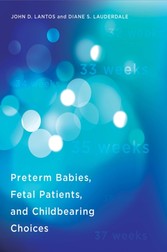Suchen und Finden
Preterm Babies, Fetal Patients, and Childbearing Choices
The United States has one of the highest rates of premature birth of any industrialized nation: 11.5%, nearly twice the rate of many European countries. In this book, John Lantos and Diane Lauderdale examine why the rate of preterm birth in the United States remains high -- even though more women have access to prenatal care now than three decades ago. They also analyze a puzzling paradox: why, even as the rate of preterm birth rose through the 1990s and early 2000s, the rate of infant mortality steadily decreased. Lantos and Lauderdale explore both the medical practices that might give rise to these trends as well as some of the demographic changes that have occurred over these years. American women now delay childbearing, for example, and have fewer babies. Doctors are better able to monitor fetal health and well-being. Prenatal care has changed, no longer focusing solely on the health of the pregnant woman. Today, the fetus has become a patient, and many preterm births are medically induced because of concern for the well-being of the fetus. Preterm birth is no longer synonymous with a bad outcome. Sometimes, it is necessary for a good one.
Alle Preise verstehen sich inklusive der gesetzlichen MwSt.












